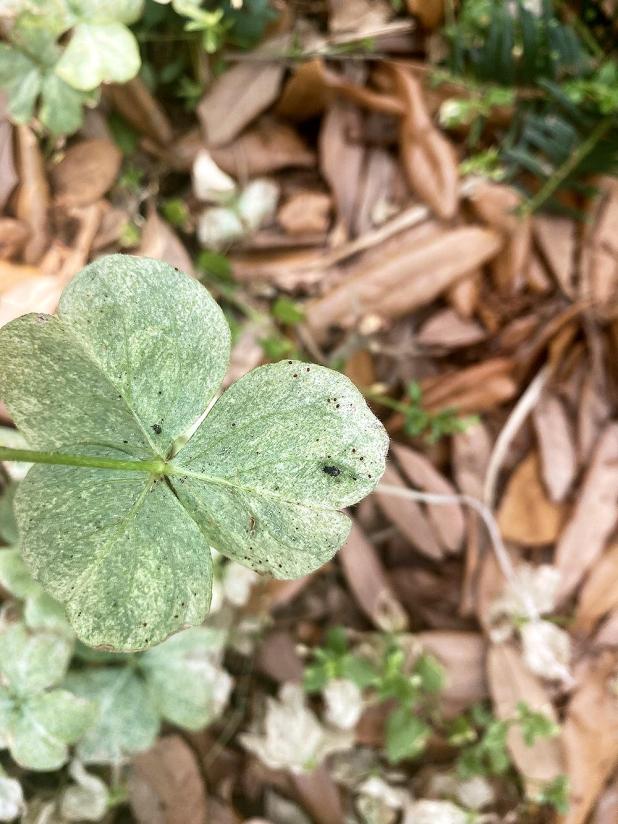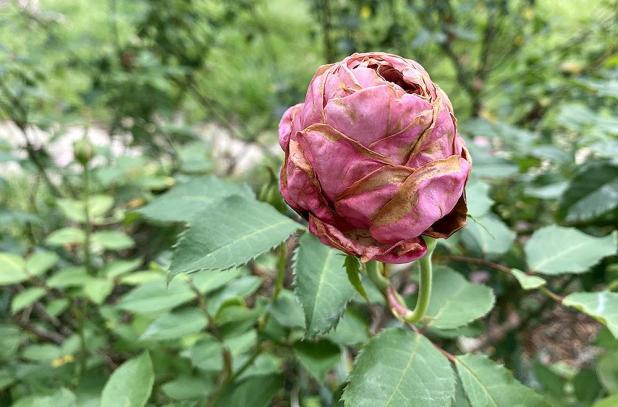
The telltale signs of spider mites are yellow or white spots or speckling of the leaves. Check the underside of leaves for webbing and mites.
—LSU AgCenter photos/Heather Kirk-Ballard

Thrips are tiny insects that can be difficult to spot with the naked eye. This rose has been damaged by thrips.
Get It Growing: Bugs are busy in spring
If you’re a gardener, you know that dealing with pests is an inevitable part of the job.
Two common pests seen on garden plants are thrips and spider mites. These tiny insects can cause damage to the leaves, flowers and fruits of your plants, and if left unchecked, can lead to stunted growth — sometimes causing major damage. Both insects feed on houseplants, flowering plants, fruit and ornamental trees and shrubs as well as vegetables.
Thrips are tiny insects that can be difficult to spot with the naked eye. Typically less than 1 millimeter long, they can range in color from yellow to brown or black. Thrips feed on the sap of plants and can result in damage to the leaves and flowers, causing them to become discolored and distorted. They also can transmit viruses from plant to plant.
Thrips can be tricky to control due to their small size and because they stay hidden within flowers and leaves and lay their eggs in the leaves to protect them. One of the best ways to prevent thrips from infesting your plants is to keep your garden clean and free of debris. Thrips thrive in warm, moist environments, so naturally they love our climate. A good gardening practice is to water your plants at the base to avoid wetting the foliage. Additionally, you can introduce natural predators, such as lacewings and ladybugs to your garden to help control the population of thrips.
If you already have a thrips infestation, there are several methods for getting rid of them. One option is to spray your plants with a natural insecticide such as neem oil or pyrethrin. These insecticides are effective at killing thrips and are safe for use on edible plants.
Another tiny garden culprit is spider mites. They are less than 1 millimeter long and can be red, brown or yellow in color. They feed on the sap of plants and can cause leaves to become yellow and dry and can eventually lead to defoliation if left unchecked. Like thrips, spider mites thrive in warm climates; however, they typically prefer dry environments, and they can reproduce quickly.
The telltale signs of spider mites are yellow or white spots or speckling of the leaves. This can be especially noticeable on the lower leaves of the plant. In addition, spider mites produce fine webbing that can be seen on the undersides of leaves or between leaves and stems. This webbing can also be visible on the plant itself, creating a dusty or dirty appearance.
To prevent spider mites from infesting your plants, be sure to keep your garden well-watered and free of dust and debris. You can also introduce natural predators such as predatory mites or ladybugs.
If you already have a spider mite infestation, there are several methods for getting rid of them. One option is to use a high-pressure hose to spray down your plants and knock the mites off, reducing their population. Another option is to use an insecticidal soap, which can be sprayed directly onto the leaves to kill spider mites. Be sure to follow the instructions carefully and avoid using too much, as this can harm your plants.
Thrips and spider mites can be a major headache for gardeners. However, with proper prevention and treatment methods, you can keep these pests at bay and keep your plants healthy and thriving. By keeping your garden clean and introducing natural predators, you can avoid infestations before they even begin. And if you do find yourself facing a thrip or spider mite infestation, there are plenty of natural and effective methods for getting rid of them.
Most plants can tolerate brief infestations, but damage is likely. The use of insecticides for thrips and spider mites management is recommended as a last resort but may be needed in cases of heavy infestation. If an insecticide application is needed, please see the Louisiana Insect Pest Management Guide (publication No. 1838) for approved insecticides to control pests on your specific type of plant. Be sure to follow the product label. Remember, insecticides can affect other beneficial insects and pollinators.
